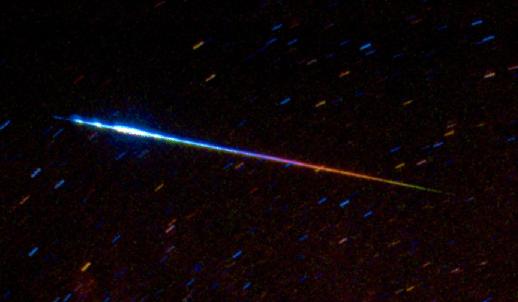Credit & Copyright: S. Kohle & B. Koch
(Astron. I., U. Bonn)
Explanation:
This weekend, the annual
Perseid
Meteor Shower reaches its maximum.
Grains of cosmic sand and gravel shed from
Comet Swift-Tuttle will
streak across the sky as they vaporize during entry into
Earth's
atmosphere.
The Perseids result from the yearly
crossing of the Earth through Comet Swift-Tuttle's orbit.
The Perseids are typically the most active
meteor shower of the year.
In a clear dark sky, an observer might see a meteor a minute
near peak times,
but this year a bright moon will overwhelm the glow from
many perseid meteors
until moonset
in the early morning hours.
Pictured above is a Perseid meteor from 1993.
The colors are representative but digitally enhanced.
As the
meteor streaked across the night sky,
different excited atoms emitted different colors of light.
The origin of the green tinge visible at the right is currently unknown,
however, and might result from
oxygen
in Earth's atmosphere.
Perseid meteors can best be seen from a relaxing position,
away from lights, just before the dawn twilight.
1999 2000 2001 2002 2003 2004 2005 2006 2007 2008 2009 2010 2011 2012 2013 2014 2015 2016 2017 2018 2019 2020 2021 2022 2023 2024 2025 |
Yanvar' Fevral' Mart Aprel' Mai Iyun' Iyul' Avgust Sentyabr' Oktyabr' Noyabr' Dekabr' |
NASA Web Site Statements, Warnings, and Disclaimers
NASA Official: Jay Norris. Specific rights apply.
A service of: LHEA at NASA / GSFC
& Michigan Tech. U.
|
Publikacii s klyuchevymi slovami:
Meteor - meteor - Perseids - Perseidy - pyatno na zvezde
Publikacii so slovami: Meteor - meteor - Perseids - Perseidy - pyatno na zvezde | |
Sm. takzhe:
Vse publikacii na tu zhe temu >> | |
